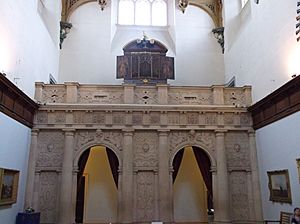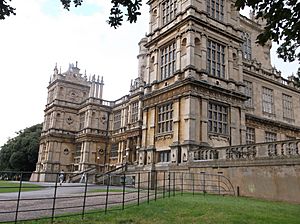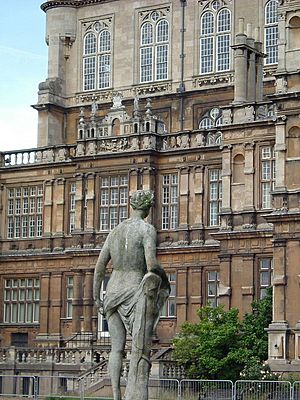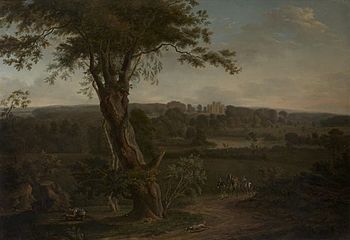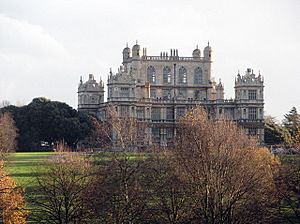Wollaton Hall facts for kids
Quick facts for kids Wollaton Hall |
|
|---|---|
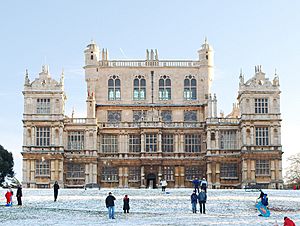
Wollaton Hall in the snow, November 2010
|
|
| Type | Prodigy house |
| Location | Nottingham, Nottinghamshire |
| Built | 1580-1588 |
| Built for | Sir Francis Willoughby |
| Architect | Robert Smythson |
| Architectural style(s) | Elizabethan |
| Owner | Nottingham City Council |
| Website | wollatonhall.org.uk |
|
Listed Building – Grade I
|
|
| Official name: Wollaton Hall | |
| Designated | 11 August 1952 |
| Reference no. | 1255269 |
|
Listed Building – Grade II*
|
|
| Official name: Camellia House 100 Metres South West of Wollaton Hall | |
| Designated | 12 July 1972 |
| Reference no. | 1255271 |
|
Listed Building – Grade II*
|
|
| Official name: Doric Temple and Attached Bridge 200 Metres South-East of Wollaton Hall | |
| Designated | 10 August 1989 |
| Reference no. | 1270389 |
| Official name: Wollaton Hall | |
| Designated | 1 January 1986 |
| Reference no. | 1000344 |
| Lua error in Module:Location_map at line 420: attempt to index field 'wikibase' (a nil value). | |
Wollaton Hall is a grand old house from the 1580s. It sits on a small hill in Wollaton Park, Nottingham, England. This amazing building is now the Nottingham Natural History Museum. You can also find the Nottingham Industrial Museum in its other buildings. The park around the hall is home to a herd of deer. It's also a popular spot for big outdoor events, like concerts and festivals.
Contents
Building Wollaton Hall: A Grand Elizabethan Home
Wollaton Hall was built between 1580 and 1588. It was made for Sir Francis Willoughby. People believe the famous Elizabethan architect, Robert Smythson, designed it. He had already finished Longleat and later designed Hardwick Hall.
The design of Wollaton Hall was very popular. Many other houses copied its general layout. However, Wollaton's fancy decorations make it special. It's even possible that Sir Francis Willoughby helped create some of these unique designs. The style is a mix of Elizabethan and early Jacobean styles.
Wollaton Hall is known as a "prodigy house." These were huge, fancy homes built to show off wealth and power. Building it was a big project for Sir Francis. He mostly paid for it with money from his coalmining business. The original family home was actually at the bottom of the hill. Even though the inside has changed a lot, the amazing outside of the hall looks much like it did centuries ago.
In 1603, Sir Percival Willoughby, Sir Francis's son, welcomed important guests to Wollaton. These included Anne of Denmark and her children, Prince Henry and Princess Elizabeth. Later, Charles I visited in 1604.
Exploring Wollaton Hall's Design
The main part of Wollaton Hall has a huge central hall that is three stories tall. It has a stone screen at one end and galleries on both sides. Above the hall is the "Prospect Room." From here, you can see amazing views of the park and the countryside. There are tall towers at each corner of the building. Each corner of the house also has a square, three-story pavilion with decorative features. Much of the lowest floor is carved right out of the rock the house sits on.
The building is made from Ancaster stone from Lincolnshire. It's said that the stone was paid for with coal from Sir Francis Willoughby's mines. Even the workers were sometimes paid with coal! In 1702, Cassandra Willoughby, Duchess of Chandos wrote that master builders and some statues came from Italy. You can see this in the decorative gondola mooring rings carved on the outside walls. There are also influences from French and Dutch designs. The outside and the main hall have lots of detailed carvings. These include strapwork and many other decorative shapes. The windows on the upper floors and the busy decorations make the hall look a bit like a "fantasy-Gothic" castle.
Wollaton Hall's Later Life
The house was empty for about 40 years after a fire in 1642. It was used again starting in 1687. Then, the inside of the hall was changed many times. Paintings on the ceilings of the two main staircases were done around 1700. These are thought to be by Sir James Thornhill and maybe Louis Laguerre. More changes were made by Wyatville starting in 1801 and continued until the 1830s.
The main hall still looks much like it did in Elizabethan times. It has a "fake hammerbeam" wooden ceiling from the 1580s. These large beams look like they support the roof, but they are actually just for decoration. The real support comes from hidden beams above.
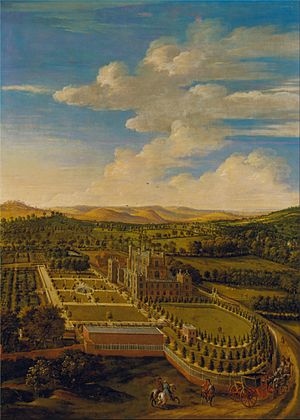
The gallery in the main hall has Nottinghamshire's oldest pipe organ. It is believed to be from the late 1600s. This organ is still played by hand! Below the hall, there are many cellars and secret passages. There's also a well and a water tank. Some stories say that an admiral from the Willoughby family used to take a daily bath in this tank.
The Willoughby family was known for its explorers. The most famous was Sir Hugh Willoughby. He sadly died in the Arctic in 1554 while trying to find a North East passage to Cathay (China). Willoughby's Land is named after him.
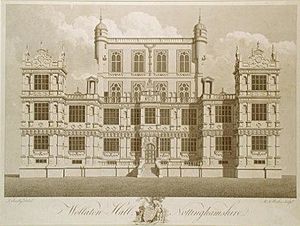
By 1881, the head of the Willoughby family, Digby Willoughby, 9th Baron Middleton, still owned the house. However, it was becoming too close to the busy city of Nottingham. So, the previous owner, Henry Willoughby, 8th Baron Middleton, started renting out the house. In 1881, it was empty.
In 1925, the 11th Baron Middleton sold Wollaton Hall to the Nottingham Corporation for £200,000. This amount would be worth about £8.18 million today. The family's old papers are now kept at The University of Nottingham. These papers include important historical documents like the Wollaton Antiphonal and a rare 13th-century story called Le Roman de Silence.
Nottingham Council opened the hall as a museum in 1926. It was closed for two years for updates and reopened in April 2007. The Prospect Room at the top and the kitchens in the basement are now open to the public. You can visit them on special guided tours. These tours last about an hour and have a small fee.
In 2011, parts of the Batman movie The Dark Knight Rises were filmed outside Wollaton Hall. The Hall was used as Wayne Manor, Batman's home. Interestingly, the Hall is only five miles north of Gotham, Nottinghamshire. The famous Gotham City in Batman stories got its name indirectly from this small English village!
Wollaton Hall Gardens
Wollaton Hall Park is a very important historical park. It is listed on the Register of Historic Parks and Gardens.
The Camellia House, which is a greenhouse for camellia plants, is a historic building itself. Many other buildings and structures in the park are also listed as important. These include a doric temple and a Ha-Ha (a hidden ditch that acts as a fence).
Who Owned Wollaton Hall?
Here is a list of the main owners of Wollaton Hall over the centuries:
- 1580–1596: Sir Francis Willoughby
- 1596–1643: Sir Percival Willoughby
- 1643–1672: Francis Willoughby
- 1672–1729: Thomas Willoughby, 1st Baron Middleton
- 1729–1758: Francis Willoughby, 2nd Baron Middleton
- 1758–1774: Francis Willoughby, 3rd Baron Middleton
- 1774–1781: Thomas Willoughby, 4th Baron Middleton
- 1781–1800: Henry Willoughby, 5th Baron Middleton
- 1800–1835: Henry Willoughby, 6th Baron Middleton
- 1835–1856: Digby Willoughby, 7th Baron Middleton
- 1856–1877: Henry Willoughby, 8th Baron Middleton
- 1877–1922: Digby Wentworth Bayard Willoughby, 9th Baron Middleton
- 1922–1924: Godfrey Ernest Percival Willoughby, 10th Baron Middleton
- 1924–1925: Michael Guy Percival Willoughby, 11th Baron Middleton
- 1925–present: Nottingham Corporation (now Nottingham City Council)
Wollaton Hall and Other Famous Buildings
In 1855, Joseph Paxton designed Mentmore Towers in Buckinghamshire. This building copied many ideas from Wollaton Hall. Both Wollaton Hall and Mentmore Towers have been used as film locations for Christopher Nolan's Batman movies. Mentmore Towers was used in Batman Begins, and Wollaton Hall was used in The Dark Knight Rises. Both buildings played the role of Wayne Manor.
Nottingham Natural History Museum
Since Wollaton Hall opened to the public in 1926, it has been home to Nottingham's natural history museum. The museum displays items from its huge collection of over 750,000 specimens. These include animals, rocks, and plants. You can see these amazing collections in six main galleries:
- Natural Connections Gallery
- Bird Gallery
- Insect Gallery
- Mineral Gallery
- Africa Gallery
- Natural History Matters Gallery
The museum started as a group interested in nature at the Nottingham Mechanics' Institution. Today, the Nottingham City Council owns it.
In 2017, the museum hosted a special exhibition of dinosaur skeletons. It was called Dinosaurs of China, Ground Shakers to Feathered Flyers. More than 125,000 people visited this exciting show.
From July 2021 to August 2022, the museum had a world-first exhibit. It showed Titus, a real Tyrannosaurus rex fossil. This amazing fossil was found in Montana, USA, in 2014.
See also
 In Spanish: Wollaton Hall para niños
In Spanish: Wollaton Hall para niños
- Grade I listed buildings in Nottinghamshire
- Listed buildings in Nottingham (Wollaton West ward)
External links
- Wollaton Hall, by Lady Middleton, from Other famous homes of Great Britain and their stories, edited by A H Malan (Putnam's, 1902), Nottinghamshire History website
- Map and aerial photos
- Photographs of Wollaton Hall from Nottingham21
- Information, photos and slide show of Wollaton Hall & Park from Rise Park Nottingham
- British Listed Buildings
- Friends of Wollaton Park information on Wollaton Hall
- Wollaton Historical & Conservation Society exists to protect and enhance the principal conservation areas, which include the old village and Wollaton Park



